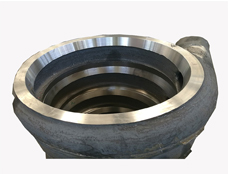+86 311 85258258
+86 311 85258258
Apr. 12, 2021
Choose The Right Impeller
The impeller is a rotating iron or steel disc with vanes in a centrifugal pump. The impeller transfers the energy from the motor driving the pump to the pumped fluid radially outward from the center of rotation by accelerating the fluid.
When the outward movement of the fluid is restricted by the pump casing, the speed reached by the water pump impeller is converted into pressure. The impeller can be used as a vortex or channel impeller.
The size of the free flow channel usually refers to the largest spherical object that can pass through the impeller.
Replacing the impeller of a water pump is usually a simple task, and every boatman should be able to complete it. Impeller pumps are much more common than you think. From bilge water and shower pumps to fresh water and seawater washing, impeller pumps are widely used. Generally speaking, they can work without surprises for many months or even years, but this does not mean that they can be maintained for free.
The choice of the impeller in sewage pump applications has an important influence on the efficiency, maintenance, and reliability of the pump.
One way to distinguish different sewage pump impellers is to check how they pass through solid matter.
The fundamental difference between the centrifugal sewage pump impeller and the clear water impeller is the ability of the former to pass solid matter, while the solid matter will cause blockage in the latter. Although the mathematical method of defining the operation of the impeller may be complicated, its purpose is simple. The impeller is designed to transfer energy to the fluid to make it flow, or, if the fluid is already flowing, to increase its height or pressure.
It does this by increasing the velocity of the fluid through the vane, as the fluid moves from the leading edge of the vane (located at the eye) to the outlet (located at the periphery). With the continuous increase of the vane radius, the rotation speed gradually increases and reaches the maximum value at the periphery. The resulting linear velocity of the fluid, at the vane outlet, is then converted into pressure in the volute.
If someone were to design a typical radial vane impeller, several guidelines would be followed quite closely. For example, the outer diameter of the impeller will closely match the outer diameter of the volute, cutting the water diameter to reduce the slippage of the pumped fluid in these areas.
In addition, according to the required hydraulic characteristics, four or more vanes will merge to flow smoothly at the vane exit. Their leading edges will also be sharpened to reduce losses caused by friction and turbulence.
Unfortunately, if the same principles are followed when designing solids handling impellers, the result will be doomed to failure. Unlike typical radial vane impellers, impellers designed to contain solid particles violate many standard design rules.

PREVIOUS: Signs Of Wore Out Impeller